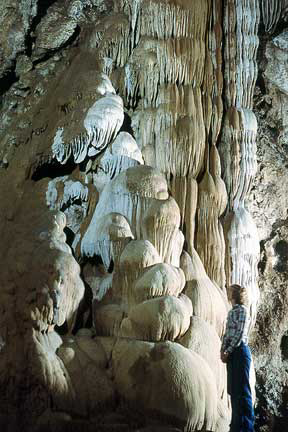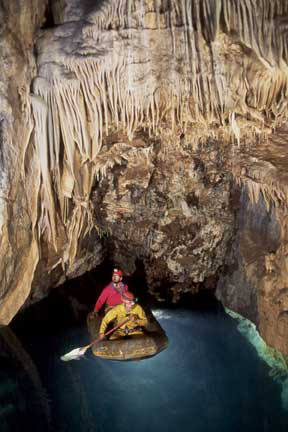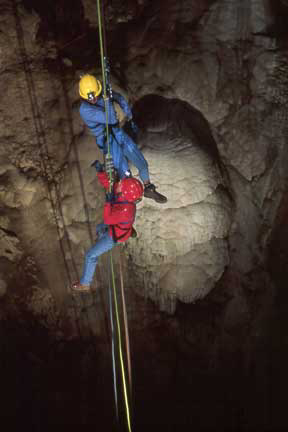Geotimes

Travels
in Geology November
2003
California cavernous treasures
 Take
a trip to Middle Earth — no, not Tolkien's land of hobbits and elves, although
the sites may not look too different from that fantasy world. Middle Earth is
one area of the California Cavern in Calaveras County, Calif. And yes, that
is the Calaveras County made famous by Mark Twain's jumping frogs. The cavern
has also hosted such notable visitors as Bret Harte and John Muir.
Take
a trip to Middle Earth — no, not Tolkien's land of hobbits and elves, although
the sites may not look too different from that fantasy world. Middle Earth is
one area of the California Cavern in Calaveras County, Calif. And yes, that
is the Calaveras County made famous by Mark Twain's jumping frogs. The cavern
has also hosted such notable visitors as Bret Harte and John Muir.
California Cavern is imbedded in limestone beds beneath the Sierra Nevada foothills.
Ten million years ago, hot brine pools formed, dissolving much of the limestone
and leaving giant caverns, says Steve Fairchild, president and founder of Underground
Adventures, which maintains the cavern and offers tours there. The limestone
was then metamorphosed into marble with the emplacement of the immense Sierra
Nevada batholith nearby. Speleothems began growing shortly after the caverns
were formed, according to dating from stalactite and stalagmite growth rings.
Moaning Cavern's spectacular speleothems
are other-worldly. Photo courtesy of Underground Adventures.
California Cavern first opened to the public after its discovery in 1850 by
a miner, and is California's first cave on exhibit, according to Fairchild.
A mining camp called Cave City was established around the cavern between 1859
and 1875, and early residents used the cavern for dances, religious services,
town meetings and weddings; there was even a bar inside.
Now a popular tourist spot, California Cavern offers three walking tours, including
the Middle Earth expedition.
The journey to Middle Earth is the longest tour, lasting three to four hours,
and is more than a mile long. Tour operators warn visitors that they will get
soaked to the skin and covered in mud on this expedition. The first hour of
the trip is crawling and wiggling through passages that connect 13 chambers
in the Mammoth Cave area. Explorers then pass into Middle Earth, a major cave
that connects Mammoth Cave to another cave — the Cave of the Quills —
that was found in the 1950s, Fairchild says. It is a large room filled with
rare speleothems, such as beaded helictites (curved, twiglike deposits of calcite
or aragonite). Here guides lead visitors through nearly knee-deep clay muck.
The remainder of the journey consists of exploring horizontal fissures in the
Cave of the Quills (named because of porcupine quills found at its mouth when
it was first discovered) and an underground rafting trip across a 200-foot-deep
lake in one of the caves.
Underground rafting in California Cavern
is certainly not an everyday experience. Photo courtesy of Underground Adventures.
Another tour, the Trail of Lights journey (aptly named because it is well-lit,
in contrast to other trails), is more suitable for the entire family. The tour
is a little more than an hour long and meanders over fairly level, lighted passages
and walkways. Experienced guides lead groups into the recently discovered Jungle
Room (named for the array of crystalline "vines" (stalactites) covering
the ceiling), and they teach the history and geology of the cavern.
Winter and early spring are an interesting time to visit California Cavern,
but you have to time it right, Fairchild says. The cave floods in the winter,
usually around Jan. 1, and small clear pools cover the ground and provide an
interesting glimpse into natural cave life. When the cave is completely flooded,
the trails close so be sure to call ahead if visiting over the winter.
Moaning Cavern is not far from California Cavern and was discovered in 1851
by gold miners hoping to strike it rich. When the prospectors realized there
was not significant gold, they abandoned the cave. Moaning Cavern was rediscovered
in 1919, and legend has it that tourists were lowered into the cavern in ore
buckets with only candles or whale oil lamps to light their way. The bones of
about 100 humans were found at the bottom of the cavern, but don't worry, they
weren't modern tourists — one skull was dated using uranium-thorium isotopes
to be 13,000 years old!
Moaning Cavern is the largest single-chamber public cavern in California. The
main room is large enough to fit the Statue of Liberty inside. The total depth
of the cave is 410 feet, though family walking tours only descend 165 feet.
The cavern was christened by early explorers who noticed a distant moaning sound
emitting from the cave. The "moan" is created by echoes of drops of
water, which falls into holes in a flowstone formation with a bottle-like shape,
Fairchild says. The sound is similar to one you can make by blowing across the
top of a partially full soda bottle, and the cave still moans today. "More
like a booming echo," Fairchild says, "but still moaning."
As at California Cavern, Underground Adventures offers varying tours of Moaning
Cavern. The Adventure Trip begins with a rappel 165 feet straight down into
the main chamber of the cavern.  While
visitors can stop there, it might be well worth spending a couple of hours exploring
the deep chambers and passages that are mostly undeveloped — meaning there
are no stairs, walkways or lights — with professional, experienced guides.
At 310 feet below ground, explorers encounter the Pancake Room, Godzilla's Nostril,
Roach Motel and Meat Grinder, among other interesting places, and will frequently
be crawling on their bellies or wading through thick mud. The total trip is
about three hours, and minors over the age of 12 must be accompanied by an adult
(no one under 12 is admitted). All equipment is provided, and again, prepare
to get dirty.
While
visitors can stop there, it might be well worth spending a couple of hours exploring
the deep chambers and passages that are mostly undeveloped — meaning there
are no stairs, walkways or lights — with professional, experienced guides.
At 310 feet below ground, explorers encounter the Pancake Room, Godzilla's Nostril,
Roach Motel and Meat Grinder, among other interesting places, and will frequently
be crawling on their bellies or wading through thick mud. The total trip is
about three hours, and minors over the age of 12 must be accompanied by an adult
(no one under 12 is admitted). All equipment is provided, and again, prepare
to get dirty.
Beginning with a 165-foot rappel deep
into the earth, a visit to Moaning Cavern is for the truly adventurous. Photo
courtesy of Underground Adventures.
Moaning Cave is open to visitors every day of the year, and fall and winter
are a great time to visit to avoid crowds, Fairchild says. November is also
the month that offers the most exploration because the water table is at its
lowest point, he adds. Moaning Cavern doesn't flood like California Cavern,
but it does get wetter in the winter, and some treks will get very wet and muddy.
Both caverns also offer gemstone and gold mining, as well as aboveground nature
trails with free trail guides to learn about the local flora and fauna, the
Gold Rush, and the original human inhabitants of the area.
California Cavern and Moaning Cavern are about 150 miles from the San Francisco
Bay Area, 70 miles from Sacramento and 100 miles from South Lake Tahoe. Nearby
sites include Columbia State Historic Park, Big Trees State Park, Sutter Gold
Mine and Bear Valley Ski Resort. What better way to begin — or end —
an adventurous family weekend than by visiting the world's natural wonders?
Megan Sever
Links:
Underground
Adventures in California
Back to top
 Take
a trip to Middle Earth — no, not Tolkien's land of hobbits and elves, although
the sites may not look too different from that fantasy world. Middle Earth is
one area of the California Cavern in Calaveras County, Calif. And yes, that
is the Calaveras County made famous by Mark Twain's jumping frogs. The cavern
has also hosted such notable visitors as Bret Harte and John Muir.
Take
a trip to Middle Earth — no, not Tolkien's land of hobbits and elves, although
the sites may not look too different from that fantasy world. Middle Earth is
one area of the California Cavern in Calaveras County, Calif. And yes, that
is the Calaveras County made famous by Mark Twain's jumping frogs. The cavern
has also hosted such notable visitors as Bret Harte and John Muir.

 While
visitors can stop there, it might be well worth spending a couple of hours exploring
the deep chambers and passages that are mostly undeveloped — meaning there
are no stairs, walkways or lights — with professional, experienced guides.
At 310 feet below ground, explorers encounter the Pancake Room, Godzilla's Nostril,
Roach Motel and Meat Grinder, among other interesting places, and will frequently
be crawling on their bellies or wading through thick mud. The total trip is
about three hours, and minors over the age of 12 must be accompanied by an adult
(no one under 12 is admitted). All equipment is provided, and again, prepare
to get dirty.
While
visitors can stop there, it might be well worth spending a couple of hours exploring
the deep chambers and passages that are mostly undeveloped — meaning there
are no stairs, walkways or lights — with professional, experienced guides.
At 310 feet below ground, explorers encounter the Pancake Room, Godzilla's Nostril,
Roach Motel and Meat Grinder, among other interesting places, and will frequently
be crawling on their bellies or wading through thick mud. The total trip is
about three hours, and minors over the age of 12 must be accompanied by an adult
(no one under 12 is admitted). All equipment is provided, and again, prepare
to get dirty.